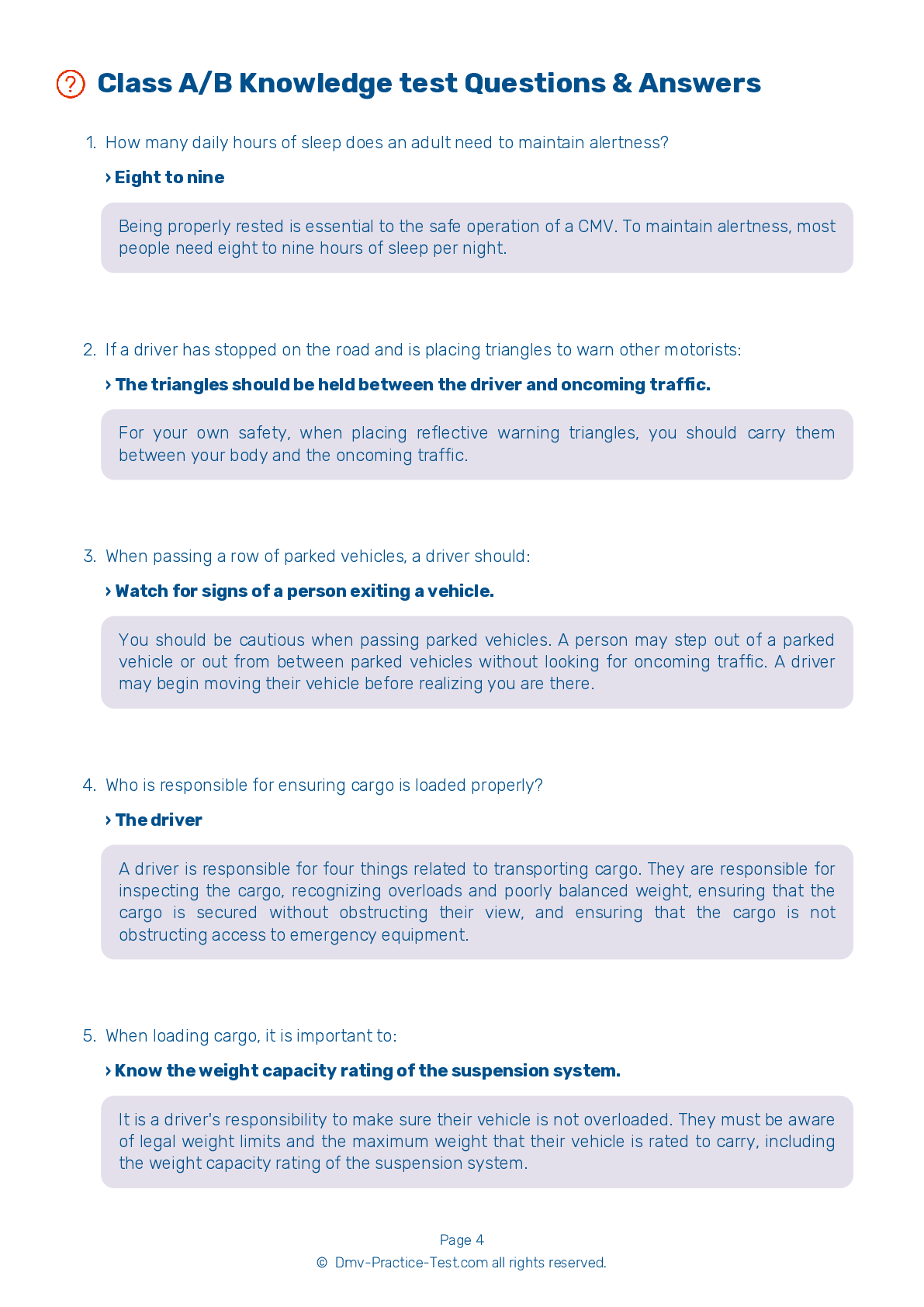HazMat #2
Hazmat Test | Virginia 2025 #2 Page 5 of 5
On our website, we provide FREE practice - CDL hazmat test online! The official exam test consists of several obligatory parts, with all of them checking your knowledge of different blocks of road rules. If you need to obtain a VA CDL hazmat endorsement in 2025, practice as much as possible. Free sample tests published on our website will help you check and improve your knowledge and boost your grades. Please bear in mind that Virginia requirements for issuing a hazmat endorsement for CDL may vary from those established in other states.
30
24
20
25 . While driving, shipping papers should be:
While hazardous materials are being transported, shipping papers should either be kept in a pouch in the driver's side door or in another location where the driver is able to easily reach them while their seat belt is fastened. The papers must be clearly visible to anyone who is entering the cab.
26 . The identification numbers assigned to chemicals can be found:
Information about hazardous chemicals is found in the Emergency Response Guide (ERG) provided by U.S. Department of Transportation (DOT). The ERG is indexed by the proper shipping names and identification numbers of substances.
27 . Placards showing the type of hazardous materials in a vehicle are usually shaped like what?
Hazardous materials warning placards are diamond-shaped.
28 . If your engine runs a pump used during delivery of compressed gas, you should turn off the engine:
Unless your engine runs a pump for product transfer, turn it off when loading or unloading a compressed gas tank. If you do use your engine to run a pump, you should turn the engine off after the product transfer but before unhooking the hoses.
29 . When a shipper packages hazardous materials, they certify:
A shipper of hazardous materials must certify on the shipping paper that the shipment has been prepared in accordance with the rules.
30 . How many identical placards must be placed on a vehicle?
A placarded vehicle must have at least four identical placards: one on the front, one on the rear, and one on each side of the vehicle.
2025 Virginia | Frequently Asked Questions
In Virginia, to secure a CDL Doubles/Triples endorsement, you must have a valid Commercial Driver's License (CDL). Start by studying the appropriate section in the Virginia CDL manual. Then, pass the written knowledge test at a DMV customer service center. You must also pass a skills test in a vehicle representative of the type you'll be driving.
To obtain a CDL Doubles/Triples license, you need a valid Commercial Driver's License (CDL). You must study the Doubles/Triples section in the CDL manual, pass a written knowledge test at your local DMV, and complete a skills test in a vehicle similar to what you plan to drive. This endorsement is required to drive vehicles pulling two or three trailers.
While Virginia doesn't mandate specialized experience or training for a CDL Doubles/Triples endorsement, it's recommended. You must have a valid CDL, pass the written knowledge test, and successfully complete a skills test in a representative vehicle. Practical training can help with these tests and safely operating such vehicles. Always check with your local DMV for specific requirements.
Yes, to obtain a CDL Doubles/Triples endorsement in Virginia, you must pass an additional written knowledge test specifically for this endorsement. This test covers topics like coupling and uncoupling, inspecting doubles and triples, and managing cargo. The test is based on the Doubles/Triples section in the CDL manual. No extra driving exam is required if you already hold a CDL.
For the CDL Doubles/Triples endorsement in Virginia, you don't have to perform a specific driving test. However, the written test covers important topics including coupling/uncoupling procedures, inspecting doubles/triples, and managing cargo. Understanding these skills is critical for safety. It's beneficial to practice these maneuvers even though they are not part of a specific driving test.
No, it's not permissible to operate double or triple trailers without a valid CDL Doubles/Triples endorsement in Virginia. The endorsement is a legal requirement that ensures you have the necessary knowledge and skills to safely operate such vehicles. Driving without the proper endorsement can result in hefty fines and penalties.
In Virginia, you can add the CDL Doubles/Triples endorsement to your existing commercial driver's license. You don't need to initiate a new application for a CDL. However, you'll need to pass the Doubles/Triples knowledge test and pay an applicable fee to add this endorsement to your current CDL.
Yes, even with a CDL Doubles/Triples endorsement, there are restrictions. In Virginia, drivers can only operate doubles/triples on specific highways and during certain hours. Also, the total weight of the trailers cannot exceed the Gross Vehicle Weight Rating. Drivers must also comply with all federal and state laws regarding rest periods and hours of service.
In Virginia, the maximum weight limit for double/triple trailers is 80,000 pounds. The maximum length for a double trailer is 61 feet for the two trailers combined, while the maximum length for a triple trailer combination is 75 feet. These limits can vary depending on the road type and may be subject to change based on state regulations.
Yes, there are specific safety guidelines for driving double/triple trailers. Drivers must ensure the securement of the cargo and conduct pre-trip inspections. They must also maintain a safe following distance, avoid sudden stops or lane changes, and understand the high rollover risk. Virginia adheres to Federal Motor Carrier Safety Regulations, which provide extensive safety rules for commercial vehicles.



